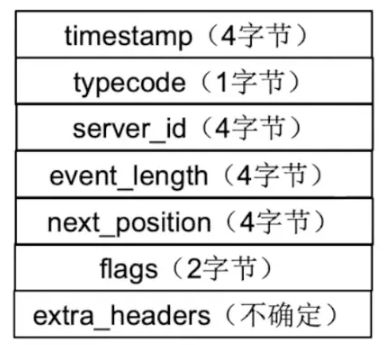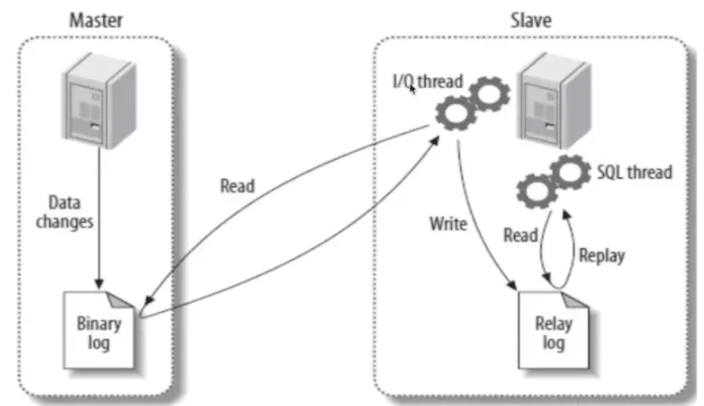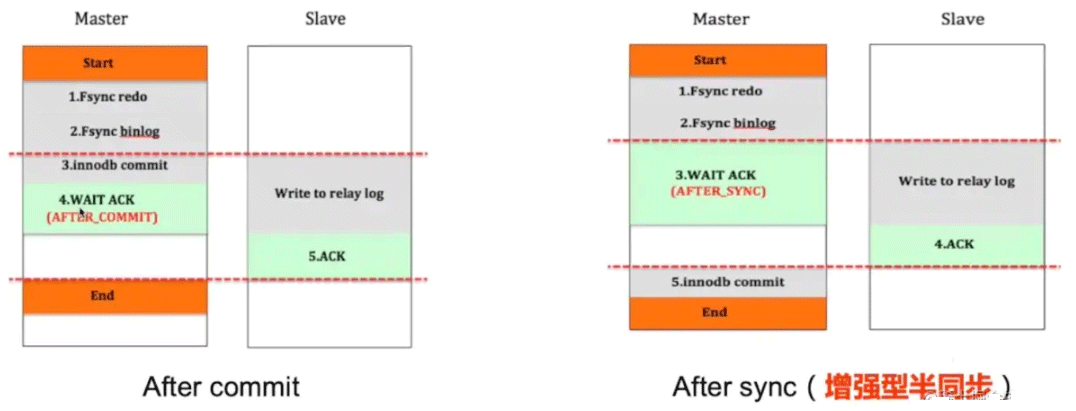What are MySQL Binlog logs and master-slave replication?
1. Introduction to Binlog log
Binlog is the abbreviation of Binary log, that is, binary log. The three main functions of Binlog include converting random IO into sequential IO for persistence, realizing master-slave replication and supporting data recovery. This article focuses on issues related to master-slave replication.
Binlog log consists of an index file and many log files. Each log file consists of a magic number and an event. Each log file ends with a Rotate type event.

For each event, it can be divided into two parts: event header and event body:
The event header The structure is as follows:

The structure of the event body includes two parts: fixed size and variable size.
As for the format of Binlog log, you can have a simple understanding. Interested students can study in depth.
2. Master-slave replication
2.1 Master-slave replication process

MySQL master-slave replication process is roughly as follows:
The main library synchronizes its own Binlog log to the slave library
The IO thread of the slave library writes the Binlog log content to the Relay Log
Get the Relay Log from the SQL thread of the library and play it back in the database
2.2 GTID
GTID refers to the global Transaction flag, used to mark master-slave synchronization.
When the master node submits a transaction, a GTID will be generated and recorded in the Binlog log. When the IO thread of the slave library reads the Binlog log, it will store it in its own Relaylog and set this value to gtid_next, which is the next GTID to be read. When reading this gtid_next from the library, it will compare Whether there is this GTID in your Binlog log:
If there is this record, it means that the transaction with this GTID has been executed and can be ignored (idempotent).
If there is no such record, the slave will execute the GTID transaction and record it in its own Binlog log.
2.3 Replication model
Asynchronous replication: master pushes the Binlog log to the slave, and the master does not need to wait until the slave After successfully updating the data to the Relay log, the main database can directly submit the transaction. This mode sacrifices data consistency.
Synchronous replication: Every time the user operates, it must be ensured that both the Master and Slave are executed successfully before returning it to the user.
Semi-synchronous replication: does not require the Slave to execute successfully, but can notify the Master to return after successfully receiving the Master log.

2.4 MGR mode
Distributed consensus algorithm Paxos. A database cluster consists of at least 3 or more nodes. Transaction submission must be approved by more than half of the nodes before it can be submitted. Multi-write mode is supported.
MGR is a share-nothing replication solution, implemented based on the distributed paxos protocol. Each instance has an independent complete copy of the data. The cluster automatically checks node information and synchronizes data. Both single-master mode and multi-master mode are provided. The single-master mode can automatically select the master after the main database goes down. All writes are performed on the master node. The multi-master mode supports multi-node writing. The cluster provides fault tolerance. As long as most nodes are running normally, the cluster can provide services normally.
2.5 Parallel playback
Transaction playback is the process of executing Relay Log from the SQL thread of the library. Parallel playback is to improve the efficiency of this process and perform transactions that can be carried out in parallel at the same time.
Parallel playback based on logical clock
Because MySQL's own transactions have ACID characteristics, the transactions from the master database to the slave database are synchronized. As long as the logical timing of their execution overlaps, the two transactions can be safely played back in parallel.
Parallel playback based on writeSet
Store the transaction set regarding a specific data block area within a certain period of time in a HashMap. Conflicts do not occur between transactions within the same group or between transactions with overlapping logical clocks, and otherwise it is impossible to determine whether a conflict exists.
The above is the detailed content of What are MySQL Binlog logs and master-slave replication?. For more information, please follow other related articles on the PHP Chinese website!

Hot AI Tools

Undresser.AI Undress
AI-powered app for creating realistic nude photos

AI Clothes Remover
Online AI tool for removing clothes from photos.

Undress AI Tool
Undress images for free

Clothoff.io
AI clothes remover

Video Face Swap
Swap faces in any video effortlessly with our completely free AI face swap tool!

Hot Article

Hot Tools

Notepad++7.3.1
Easy-to-use and free code editor

SublimeText3 Chinese version
Chinese version, very easy to use

Zend Studio 13.0.1
Powerful PHP integrated development environment

Dreamweaver CS6
Visual web development tools

SublimeText3 Mac version
God-level code editing software (SublimeText3)

Hot Topics
 How to connect to the database of apache
Apr 13, 2025 pm 01:03 PM
How to connect to the database of apache
Apr 13, 2025 pm 01:03 PM
Apache connects to a database requires the following steps: Install the database driver. Configure the web.xml file to create a connection pool. Create a JDBC data source and specify the connection settings. Use the JDBC API to access the database from Java code, including getting connections, creating statements, binding parameters, executing queries or updates, and processing results.
 MySQL: An Introduction to the World's Most Popular Database
Apr 12, 2025 am 12:18 AM
MySQL: An Introduction to the World's Most Popular Database
Apr 12, 2025 am 12:18 AM
MySQL is an open source relational database management system, mainly used to store and retrieve data quickly and reliably. Its working principle includes client requests, query resolution, execution of queries and return results. Examples of usage include creating tables, inserting and querying data, and advanced features such as JOIN operations. Common errors involve SQL syntax, data types, and permissions, and optimization suggestions include the use of indexes, optimized queries, and partitioning of tables.
 MySQL's Place: Databases and Programming
Apr 13, 2025 am 12:18 AM
MySQL's Place: Databases and Programming
Apr 13, 2025 am 12:18 AM
MySQL's position in databases and programming is very important. It is an open source relational database management system that is widely used in various application scenarios. 1) MySQL provides efficient data storage, organization and retrieval functions, supporting Web, mobile and enterprise-level systems. 2) It uses a client-server architecture, supports multiple storage engines and index optimization. 3) Basic usages include creating tables and inserting data, and advanced usages involve multi-table JOINs and complex queries. 4) Frequently asked questions such as SQL syntax errors and performance issues can be debugged through the EXPLAIN command and slow query log. 5) Performance optimization methods include rational use of indexes, optimized query and use of caches. Best practices include using transactions and PreparedStatemen
 Why Use MySQL? Benefits and Advantages
Apr 12, 2025 am 12:17 AM
Why Use MySQL? Benefits and Advantages
Apr 12, 2025 am 12:17 AM
MySQL is chosen for its performance, reliability, ease of use, and community support. 1.MySQL provides efficient data storage and retrieval functions, supporting multiple data types and advanced query operations. 2. Adopt client-server architecture and multiple storage engines to support transaction and query optimization. 3. Easy to use, supports a variety of operating systems and programming languages. 4. Have strong community support and provide rich resources and solutions.
 MySQL's Role: Databases in Web Applications
Apr 17, 2025 am 12:23 AM
MySQL's Role: Databases in Web Applications
Apr 17, 2025 am 12:23 AM
The main role of MySQL in web applications is to store and manage data. 1.MySQL efficiently processes user information, product catalogs, transaction records and other data. 2. Through SQL query, developers can extract information from the database to generate dynamic content. 3.MySQL works based on the client-server model to ensure acceptable query speed.
 How to start mysql by docker
Apr 15, 2025 pm 12:09 PM
How to start mysql by docker
Apr 15, 2025 pm 12:09 PM
The process of starting MySQL in Docker consists of the following steps: Pull the MySQL image to create and start the container, set the root user password, and map the port verification connection Create the database and the user grants all permissions to the database
 Laravel Introduction Example
Apr 18, 2025 pm 12:45 PM
Laravel Introduction Example
Apr 18, 2025 pm 12:45 PM
Laravel is a PHP framework for easy building of web applications. It provides a range of powerful features including: Installation: Install the Laravel CLI globally with Composer and create applications in the project directory. Routing: Define the relationship between the URL and the handler in routes/web.php. View: Create a view in resources/views to render the application's interface. Database Integration: Provides out-of-the-box integration with databases such as MySQL and uses migration to create and modify tables. Model and Controller: The model represents the database entity and the controller processes HTTP requests.
 Solve database connection problem: a practical case of using minii/db library
Apr 18, 2025 am 07:09 AM
Solve database connection problem: a practical case of using minii/db library
Apr 18, 2025 am 07:09 AM
I encountered a tricky problem when developing a small application: the need to quickly integrate a lightweight database operation library. After trying multiple libraries, I found that they either have too much functionality or are not very compatible. Eventually, I found minii/db, a simplified version based on Yii2 that solved my problem perfectly.






